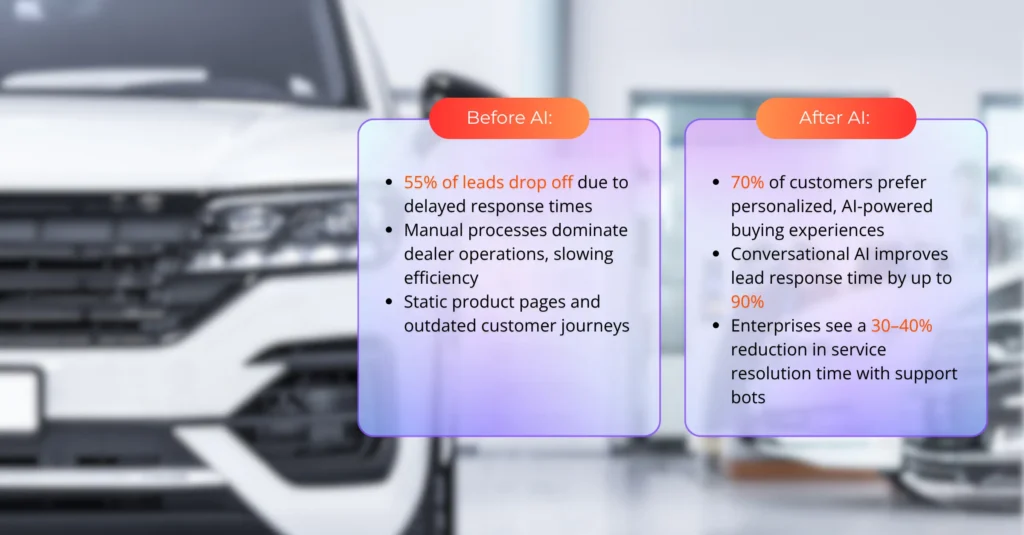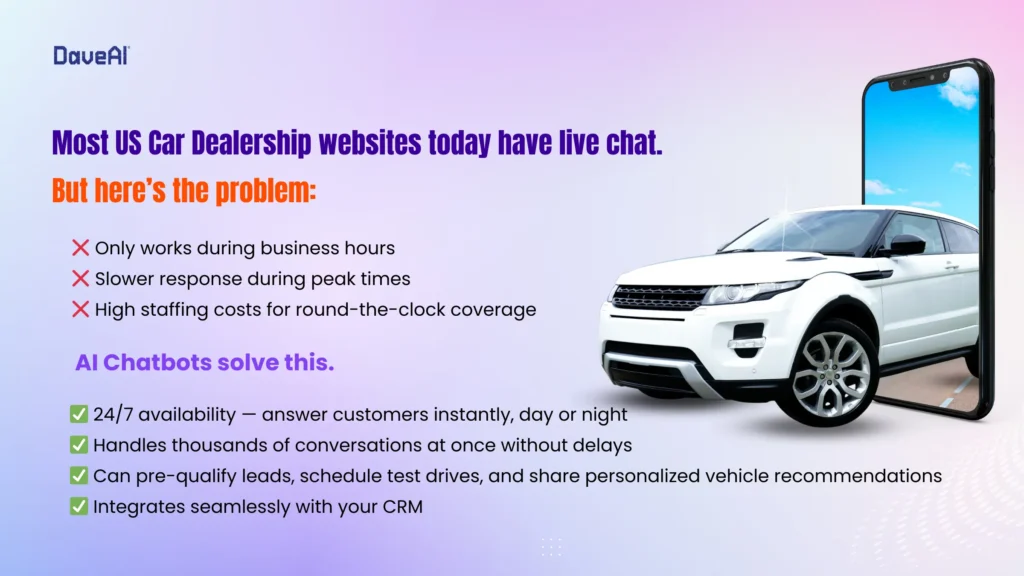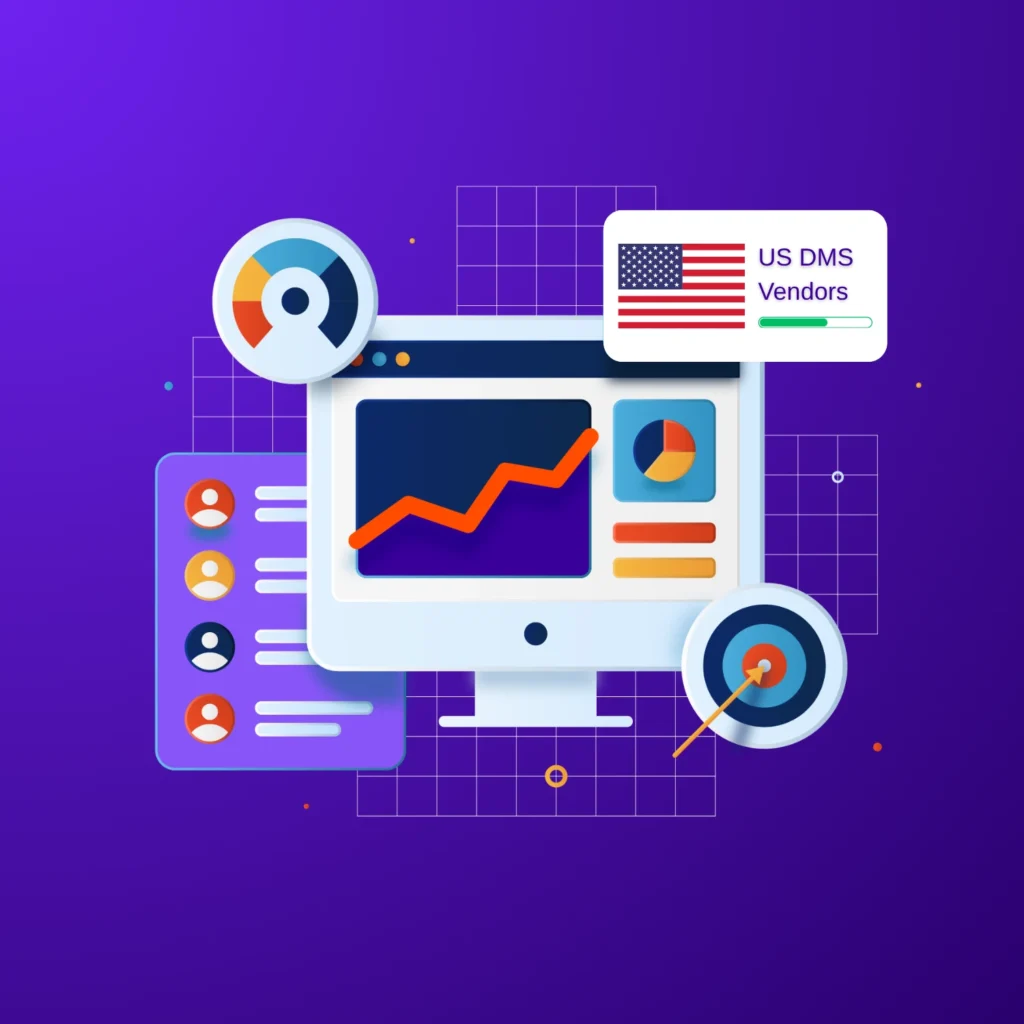The automotive industry is at a crossroads. Artificial Intelligence (AI) is no longer just a futuristic concept—it’s actively reshaping dealership operations, customer experiences, and revenue models. For auto dealers, embracing AI is no longer optional; it’s essential to stay competitive in a rapidly evolving market.
Consider these statistics: in 2025, 79.61% of auto dealers have already allocated budgets for AI implementation. The global automotive AI market is projected to expand dramatically, reaching nearly $47 billion by 2033 with a compound annual growth rate (CAGR) of over 25%. Dealers who integrate AI into their operations are seeing tangible results—lead conversion rates improve by 30–40%, sales cycles shorten, and operational efficiency rises.
The urgency is real. Waiting until 2026 to adopt AI could leave dealerships lagging behind competitors who are already leveraging data-driven insights and automation to capture more leads, close sales faster, and enhance customer satisfaction.
Key Takeaways:
- Understand the 5 critical automotive AI applications every dealership must adopt.
- Plan implementation timelines and budgets effectively.
- Measure ROI accurately and avoid common pitfalls.
- Position your dealership for sustainable competitive advantage in the AI-driven future.
The AI Revolution Already Reshaping Auto Retail
Current State of AI in Automotive Dealerships
AI is transforming how dealerships engage with customers. Chatbots, virtual assistants, and AI-powered recommendation engines are becoming standard tools for delivering personalized, 24/7 experiences.
- AI Chatbots: Capable of handling inquiries across websites, WhatsApp, and social media, AI chatbots respond instantly, reducing wait times and boosting customer satisfaction.
- Virtual Sales Assistants: Offer real-time vehicle recommendations, financing options, and trade-in valuations based on customer data and preferences.
- Predictive Insights: AI evaluates customer behavior to anticipate needs, such as service reminders, model upgrades, or personalized offers.
Dealerships implementing AI report higher engagement rates, increased lead-to-sale conversions, and improved customer loyalty. The efficiency gains are tangible—AI-driven communication reduces manual follow-ups, freeing sales staff to focus on closing deals and high-value interactions.
Market Forces Driving AI Adoption
Several external and internal pressures are accelerating AI adoption in dealerships:
- Competitive Pressure: Direct-to-consumer (DTC) models, led by Tesla and other EV manufacturers, bypass traditional dealerships. Auto dealers must modernize with digital-first sales experiences or risk obsolescence.
- Consumer Expectations: Modern buyers expect seamless digital journeys, including online research, virtual demos, instant financing, and personalized recommendations. AI enables dealers to meet these expectations efficiently.
- Labor Shortages: Many dealerships face staffing challenges. AI solutions automate repetitive tasks such as lead follow-up, inventory management, and service scheduling, allowing human employees to focus on strategic and customer-facing tasks.
- Data-Driven Decisions: AI helps dealers analyze vast volumes of market and customer data to make informed pricing, stocking, and marketing decisions that maximize ROI.
Early Adopter Advantages
Dealerships embracing AI early gain immediate competitive advantages:
- Operational Efficiency: AI reduces manual workload, streamlines processes, and optimizes inventory management.
- Revenue Growth: Predictive analytics improve lead qualification and sales outcomes.
- Customer Experience Differentiation: Personalized recommendations, 24/7 support, and proactive service alerts build stronger loyalty.
For example, dealers using AI-driven chatbots have reported up to 40% faster lead response times and 30% higher lead-to-sale conversion rates. This early adoption not only strengthens market position but also enhances long-term sustainability.
5 Mission-Critical AI Applications for Auto Dealers
Intelligent Customer Engagement & Lead Management
AI transforms the lead management process, ensuring that every potential buyer is engaged promptly and efficiently.
- AI-Powered Chat and Communication: Platforms integrate chatbots across WhatsApp, SMS, and email, ensuring instant responses (often under two minutes). Multilingual support allows dealerships to reach diverse markets.
- Lead Scoring & Qualification: Predictive analytics assess lead quality, prioritize hot leads, and trigger automated follow-ups based on customer behavior.
- Integration with CRM: AI integrates seamlessly with existing CRM systems, ensuring a holistic view of customer interactions and improving sales team productivity.
These technologies ensure no lead is lost, increasing the likelihood of conversion while reducing manual workload.
Inventory Optimization and Pricing Intelligence
Managing inventory efficiently is critical to profitability. AI enables:
- Dynamic Pricing Strategies: Real-time analysis of market trends, competitor pricing, and historical sales data allows dealerships to set optimal prices for each vehicle.
- Demand Forecasting: AI predicts which models, trims, and options will sell quickly, helping dealers maintain ideal inventory levels.
- Automated Stocking and Turn Rate Optimization: AI recommends reordering and allocation strategies, minimizing overstock and reducing inventory holding costs.
By leveraging AI, dealerships can optimize pricing and inventory, reduce lost sales opportunities, and maximize profitability.
Service Department Automation
AI extends beyond sales into service operations:
- Predictive Maintenance Alerts: Anticipates vehicle service needs, preventing unexpected downtime and improving customer retention.
- Automated Scheduling: AI recommends the best time slots for service appointments and predicts parts inventory requirements.
- Enhanced Service Efficiency: AI streamlines workflows, ensuring technicians have the right parts and tools ready, reducing service delays.
These capabilities not only improve customer satisfaction but also increase service department revenue.
Sales Process Enhancement
- Virtual Sales Assistants: AI agents provide detailed vehicle information, financing options, and trade-in valuations. They act as independent digital sales team members, available anytime, anywhere.
- Product Configuration Engines: Allow customers to personalize vehicles online, with AI recommending the best trims and features based on their preferences.
- Financing Optimization: AI evaluates customer credit data and automates financing recommendations for faster approvals.
Marketing and Customer Analytics
AI-driven marketing ensures campaigns reach the right audience at the right time:
- Behavioral Analytics: AI tracks customer behavior to personalize offers and predict future needs.
- Automated Campaigns: Marketing automation tools execute campaigns across email, SMS, and social platforms while tracking performance in real time.
- ROI Measurement: AI analyzes campaign impact across all touchpoints, providing insights into which strategies drive the highest conversions.
Implementation Roadmap: Getting Started Right

Phase 1: Foundation Building (Months 1–3)
Assessment and Planning
- Current technology audit: The first step involves taking stock of existing systems—dealership management systems (DMS), CRM platforms, marketing tools, and communication channels. This audit identifies what’s outdated, what can be integrated, and where the biggest gaps lie.
- Staff readiness evaluation: A successful transformation is as much about people as it is about technology. Conduct surveys, interviews, or workshops to gauge employees’ comfort levels with AI tools. Identifying potential champions and resistance points early helps in smoother adoption.
- Budget allocation and ROI goal setting: Instead of seeing AI as a cost center, businesses should define expected outcomes—whether that’s faster lead conversions, higher service bookings, or improved customer satisfaction. Setting measurable ROI goals ensures investments are aligned with business outcomes.
- Vendor selection criteria: Choosing the right technology partner is critical. Criteria should include integration capability, scalability, data security compliance, customer support, and industry expertise. A vendor with proven automotive experience provides a significant advantage.
Quick Wins Implementation
- Basic chatbot deployment: Simple AI chatbots can be set up on dealership websites or WhatsApp to answer FAQs, provide dealership hours, or schedule callbacks. This creates immediate customer engagement while reducing staff workload.
- Lead response automation: Many dealerships lose leads due to delayed responses. Automating first-touch responses via AI ensures every inquiry receives an instant acknowledgment, improving conversion chances.
- Simple inventory alerts: Automated alerts for new arrivals, discounts, or out-of-stock updates give customers real-time visibility into inventory, boosting engagement and driving quicker purchase decisions.
By the end of Phase 1, dealerships will have immediate improvements in customer engagement while laying the groundwork for deeper AI integration.
Phase 2: Core System Integration (Months 4–9)
CRM and DMS Integration
- Data synchronization protocols: Integrating AI with CRM and DMS allows seamless flow of customer and vehicle data. This ensures that sales, service, and marketing teams access unified customer profiles, minimizing errors and redundancies.
- Staff training and change management: Employees must be trained not just on how to use AI tools, but also on how these tools change workflows. Change management sessions help address skepticism and create buy-in from staff.
- Performance monitoring setup: Implementing KPIs and dashboards helps track how AI is impacting lead response time, sales conversions, service efficiency, and customer satisfaction. Early monitoring helps detect bottlenecks before they escalate.
Advanced Features Rollout
- Predictive analytics implementation: With integrated data, AI can now forecast customer buying patterns, identify leads most likely to convert, and predict when customers will need service. This enables proactive selling and service reminders.
- Service automation deployment: AI-powered scheduling systems automatically suggest optimal service slots, reducing manual errors and improving workshop efficiency. Virtual assistants can also provide service updates to customers in real time.
- Marketing automation activation: Personalized marketing campaigns can be triggered based on customer behavior—such as sending financing options to high-intent buyers or reminding customers of expiring warranties.
By the end of Phase 2, dealerships will see smoother workflows, higher efficiency, and improved personalization—directly impacting revenue and customer loyalty.
Phase 3: Optimization and Scaling (Months 10–12)
Performance Analysis and Refinement
- ROI measurement and reporting: The impact of AI adoption should now be measured against initial ROI goals. This includes metrics like reduction in lead response times, uplift in service bookings, or percentage growth in digital leads.
- System optimization based on data: Performance reviews help refine AI workflows—whether by retraining chatbots to handle new queries or adjusting predictive algorithms to account for seasonal sales patterns.
- Advanced feature utilization: By now, dealerships can start using advanced capabilities such as AI-driven upselling recommendations, voice assistants for call centers, or AR/VR-enabled virtual showrooms.
Future-Proofing Strategies
- Emerging technology evaluation: AI evolves rapidly. Dealerships should continuously explore upcoming technologies like generative AI-powered vehicle configurators, conversational commerce on social platforms, or voice-first digital assistants in cars.
- Continuous improvement processes: Establishing a feedback loop ensures AI tools are updated regularly with customer input and business performance data. This keeps the system relevant and effective.
- Competitive advantage maintenance: The goal is not just adoption, but differentiation. Regular innovation, faster deployment of new features, and proactive customer engagement will help dealerships stay ahead of competitors.
By the end of Phase 3, dealerships will have a fully optimized, AI-driven ecosystem that is not only efficient today but also adaptable for the future.
ROI Analysis: The Business Case for Automotive AI Investment

Cost-Benefit Analysis Framework
Before AI proves its ROI, it’s important to understand the investment structure:
- Software Licensing & Setup Costs: Includes subscriptions for AI tools such as chatbots, predictive analytics engines, and virtual assistants.
- Integration & Customization Expenses: Covers API work, CRM/DMS integration, UI adjustments, and data pipelines.
- Training & Change Management Budget: Ensures sales, service, and admin staff know how to maximize the tools.
- Ongoing Maintenance & Support: Budget for updates, vendor support, data hosting, and performance monitoring.
While initial costs can be significant, most well-planned AI implementations begin to yield returns within 6–12 months.
Measurable ROI Metrics
Where AI distinguishes itself is in delivering tangible improvements across core dealership operations:
1. Sales Performance Improvements
- Lead Conversion Rate Increases (25–40%): AI scores and prioritizes leads, enabling more effective follow-up by sales staff.
- Sales Cycle Reduction (15–30%): Automated response and scheduling accelerate the path to purchase.
- Customer Lifetime Value (CLV) Enhancement: Personalized AI touchpoints—service reminders, upsells—deepen loyalty.
- Cross-Selling & Upselling Optimization: AI identifies the right time and offer to suggest add-ons like warranties or accessories, boosting average transaction value.
2. Operational Efficiency Gains
- Staff Productivity Improvements: Automation of routine tasks frees staff to focus on high-impact work.
- Reduced Manual Task Time: Chatbots and scheduling systems handle much of the inquiry and appointment workload.
- Inventory Turn Rate Optimization: Forecasting tools align stock levels with demand—less overstock or stockouts.
- Service Department Efficiency: Predictive scheduling and parts planning reduce idle time and improve throughput.
Real-World ROI Examples
Here are three U.S. dealerships demonstrating successful AI ROI, with active links to learn more:
Herb Chambers Companies (Boston, MA)
Implemented AI-driven chatbots and lead automation. Results:
- 60% faster lead response times
- 32% improvement in conversion rates
- 20% decrease in service no-shows via automated reminders
Learn more about Herb Chambers’ AI deployment
Napleton Automotive Group (Chicago, IL)
Deployed AI-based predictive analytics and marketing automation:
- 28% increase in upselling premium trims and accessories
- 15% reduction in inventory holding costs
- Boosted staff efficiency through automated online inquiry handling
Explore Napleton’s AI results in detail
Common Pitfalls and How to Avoid Them
- Technology Implementation Mistakes: Avoid over-engineering; start with pilot programs and scale gradually.
- Staff Adoption Challenges: Comprehensive training and transparent communication about AI roles ensure smooth adoption.
- Vendor Selection Errors: Assess vendor experience in the automotive sector, integration capabilities, and scalability options.
Preparing Your Dealership for 2026 and Beyond
Future AI Trends
- Autonomous driving and AI-driven vehicle inspections.
- Voice AI and NLP for advanced customer interactions.
- Computer vision for automated vehicle inspections.
- Blockchain for transparent transaction histories.
Competitive Landscape Evolution
Dealerships that harness AI effectively will differentiate themselves through superior customer experience, inventory management, and operational efficiency.
Immediate Action Steps (30-60-90 Day Plan)
- Weeks 1–2: Assess technology and define goals.
- Month 1: Evaluate and select vendors.
- Month 2: Launch pilot programs.
- Month 3: Analyze results and plan scale-up.
Conclusion: The Time to Act is Now
AI adoption is accelerating rapidly. Early adopters gain tangible advantages in sales, customer satisfaction, and operational efficiency. With careful planning and phased implementation, dealerships can reap significant benefits while avoiding common pitfalls.
Call to Action:
- Audit your current technology stack.
- Identify high-impact AI use cases.
- Begin vendor discussions and pilot programs immediately.
By 2026, AI will be table stakes for competitive dealerships. The question isn’t whether to implement AI—it’s how effectively and quickly you act.



